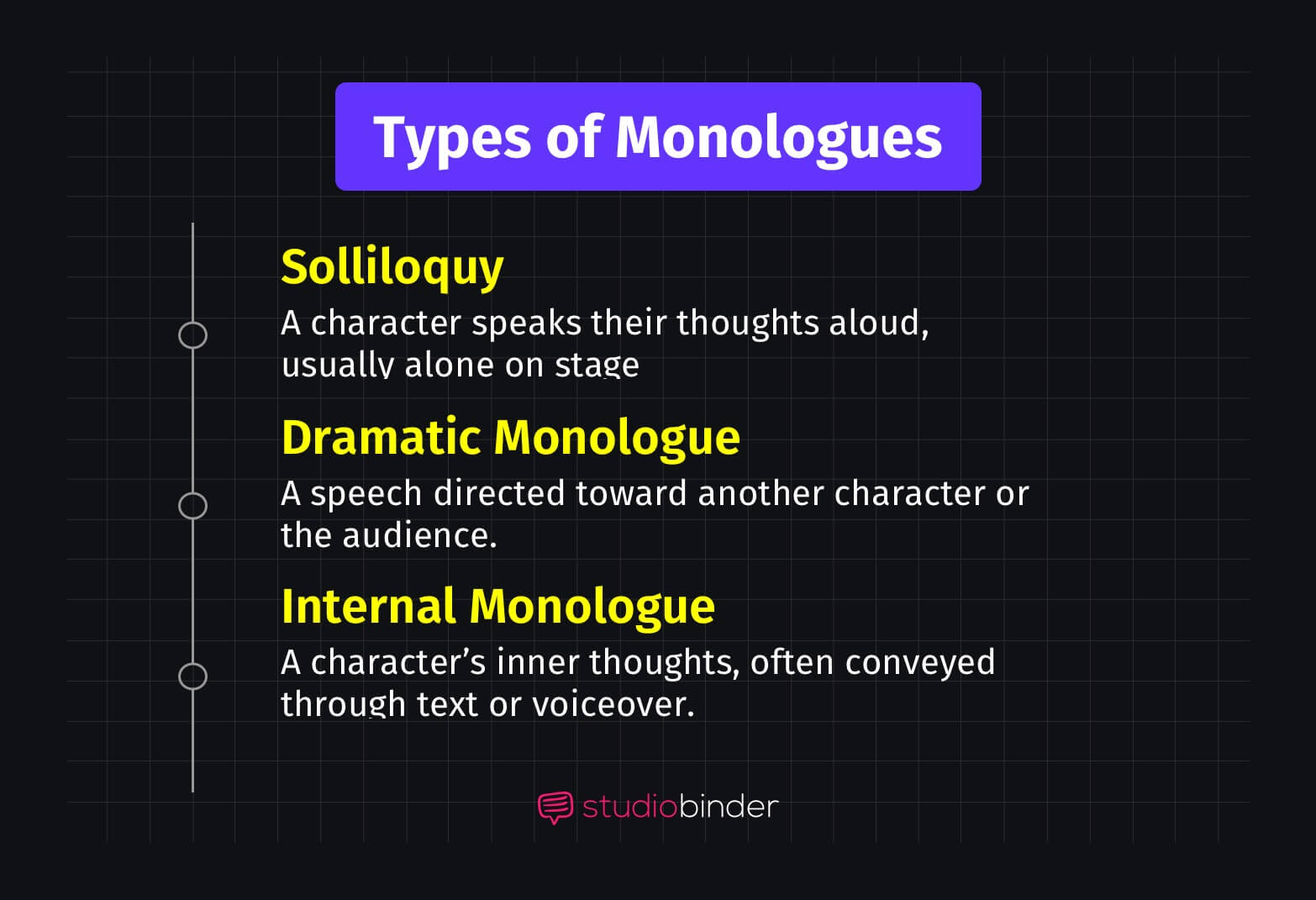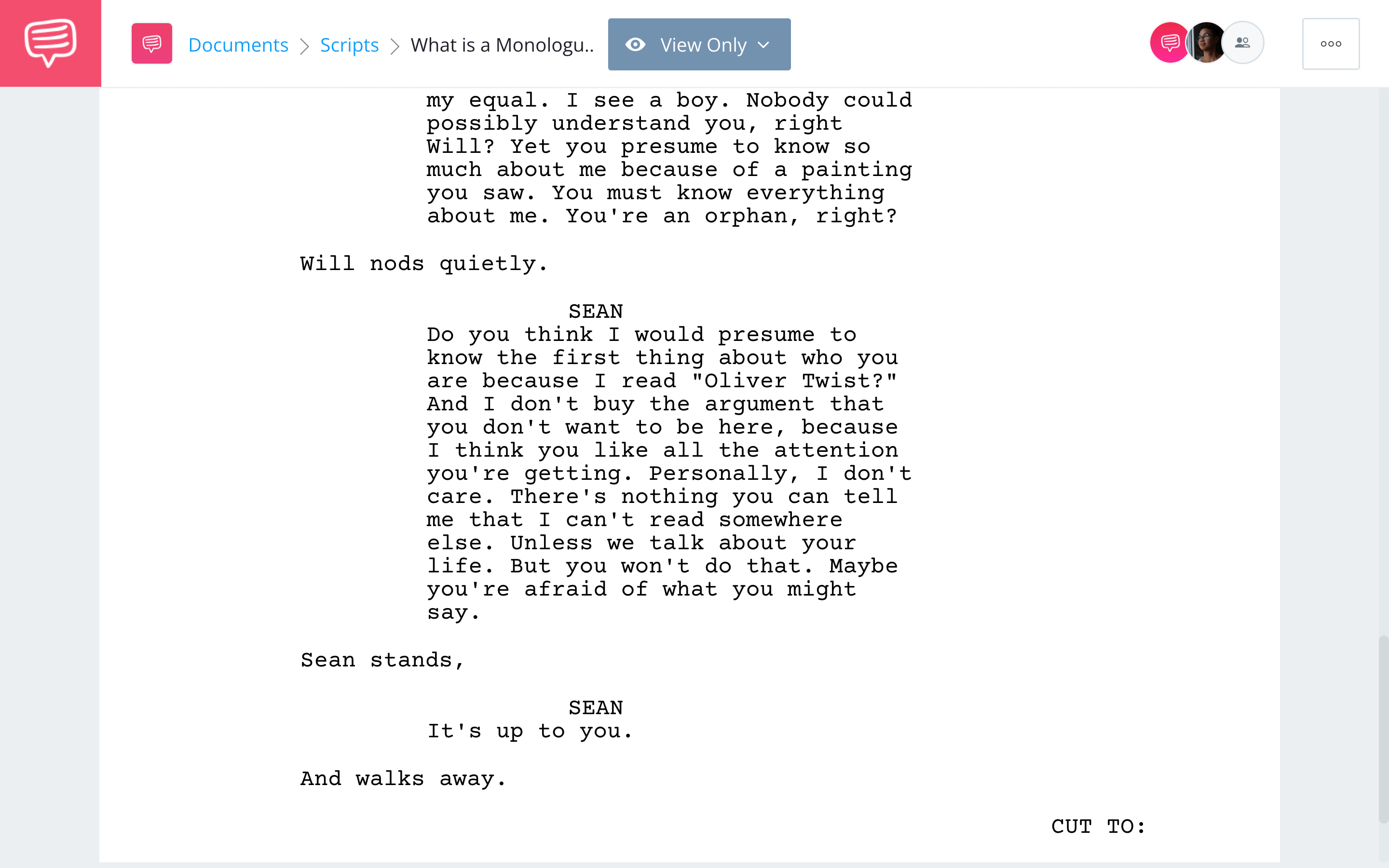What is a monologue? Some of the most iconic lines in the history of literature and cinema have come from monologues. As a character spills their thoughts and emotions into a speech, they often create memorable lines that connect to other characters and the audience. In this article, we’ll explore the monologue meaning and its significance in storytelling and analyze iconic examples. We’ll also look at the three types of monologues with examples of each. Let’s dive in.
What is a Monologue
Monologue definition & meaning
Screenwriting is a skill, but writing dialogue is an art unto itself. What writer wouldn't want to indulge in a flowing and expansive speech? Well, as most writing teachers will tell you, this is an indulgence in which one should only partake when necessary. A successful monologue, in other words, is a strategic one.
Before we take a look at how writers craft monologues, let’s first explore the definition of monologue to gain a better understanding of their purpose.
MONOLOGUE DEFINITION
What is a monologue?
A monologue is a long form speech delivered by a single character in a play or a film. The term monologue derives from the Greek words “monos” which translates to “alone” and “logos” which means “speech.” These speeches are used by writers to express a character’s thoughts, emotions, or ideas. Depending on what type of monologue is used, the character can be addressing themself, another character, or the audience.
Types of Monologues:
- Soliloquy
- Dramatic
- Internal
What is a Monologue Used For?
Define monologue in storytelling
A story is made up of bits of information that are communicated to the audience over time. When it comes to information regarding a character’s thoughts or emotions, a monologue is effective at efficiently communicating this info to the audience and/or to another character.
A monologue is often the vocalization of a character’s thoughts, giving insight that reveals details about a story’s plot or its characters. Understanding the monologue meaning helps writers and actors utilize these speeches effectively to enhance storytelling. This character’s speech in and of itself can propel the story forward based on how other characters react to it and what events are caused by it.
A great example of this can be found in the Good Will Hunting script. Will (Matt Damon) is resistant to any court-mandated therapist. However, this monologue by Sean (Robin Williams) causes Will to finally be open to meeting further with him.
We brought the iconic monologue into StudioBinder's screenwriting software to analyze it further. Click the image below to read the entire scene. With writing this good, no wonder this won the Oscar for Best Screenplay.
Good Will Hunting script • Read the entire scene
As you can see, this monologue does multiple things simultaneously for the film’s story. It reveals exposition about Sean. We learn he is a veteran, that he loved his wife deeply, and that he lost his wife to cancer.
At the same time, the monologue propels the plot forward by allowing Sean to finally break through to Will.
Good monologues will either reveal character information or plot info. A great monologue will reveal both while moving the story forward all at the same time. Let’s take a look at the different types of monologues you can use in your work.
Related Posts
What is a Monologue in Literature and Film?
Monologue meaning & types
If you’ve ever asked, “What is a monologue?", it’s one of the most powerful tools in storytelling—used across plays, films, literature, and poetry. They allow characters to express their thoughts, emotions, or motivations in extended speeches.
A monologue can serve many purposes:
- Reveal a character’s internal conflict
- Provide exposition or backstory
- Advance the plot through key revelations
- Deliver a memorable moment of emotional or philosophical depth
There are three primary types of monologues, each defined by who the monologue is addressed to and how it functions within a narrative.
Types of Monologues
Monologues can be categorized based on their function and delivery style. The three main types are:

Types of Monologues
Let’s explore each in detail with examples.
What is a Monologue
Monologue definition in theater
To better understand how monologues function, let’s start with the basics—what is a monologue, exactly? Then we’ll explore one of its key forms: the soliloquy. A soliloquy is a type of monologue where a character speaks their thoughts out loud, usually when alone on stage or screen. Unlike a dramatic monologue, soliloquies are not meant to be heard by other characters—they provide insight into the speaker’s internal struggles.
Famous example: Hamlet’s “To Be or Not to Be”
One of the most well-known soliloquies in history comes from a play. Shakespeare’s “To Be or Not to Be” is among the most studied monologues from plays in theater history.
Here, in existential speech from the marquee character in Hamlet:
To be, or not to be, that is the question:
Whether 'tis nobler in the mind to suffer
The slings and arrows of outrageous fortune,
Or to take arms against a sea of troubles
And by opposing end them. To die—to sleep,
No more; and by a sleep to say we end
The heart-ache and the thousand natural shocks
That flesh is heir to: 'tis a consummation
Devoutly to be wish'd. To die, to sleep;
To sleep, perchance to dream—ay, there's the rub:
For in that sleep of death what dreams may come,
When we have shuffled off this mortal coil,
Must give us pause—there's the respect
That makes calamity of so long life.
For who would bear the whips and scorns of time,
Th'oppressor's wrong, the proud man's contumely,
The pangs of dispriz'd love, the law's delay,
The insolence of office, and the spurns
That patient merit of th'unworthy takes,
When he himself might his quietus make
With a bare bodkin? Who would fardels bear,
To grunt and sweat under a weary life,
But that the dread of something after death,
The undiscovere'd country, from whose bourn
No traveller returns, puzzles the will,
And makes us rather bear those ills we have
Than fly to others that we know not of?
Thus conscience doth make cowards of us all,
And thus the native hue of resolution
Is sicklied o'er with the pale cast of thought,
And enterprises of great pith and moment
With this regard their currents turn awry
And lose the name of action.
— Hamlet
In this soliloquy, Hamlet debates the value of life and the fear of the unknown after death. Because he is alone, the audience understands that this is his most honest, unfiltered reflection on his predicament.
Why soliloquies work
- Reveal the deepest truths about a character
- Create intimacy between the audience and the speaker
- Establish strong dramatic irony—the audience knows something other characters don’t
What is a Monologue?
Define monologue in character thoughts
An internal monologue represents a character’s unspoken thoughts, often written in literature or conveyed through voiceover in film. It allows the audience to experience a character’s personal reflections, anxieties, or dreams without vocalization.
Famous example: The Love Song of J. Alfred Prufrock
T.S. Eliot’s poem contains a masterful internal monologue. The character, Prufrock, is lost in self-doubt and anxiety, hesitating to act:
And indeed there will be time
To wonder, “Do I dare?” and, “Do I dare?” —
Time to turn back and descend the stair,
With a bald spot in the middle of my hair—
(They will say: “How his hair is growing thin!”)
My morning coat, my collar mounting firmly to the chin,
My necktie rich and modest, but asserted by a simple pin—
(They will say: “But how his arms and legs are thin!”)
Here, Prufrock’s internal monologue reveals his crippling self-consciousness, fixating on how others perceive his appearance. The repetition of “Do I dare?” highlights his hesitation and inability to act. His anxious thoughts spiral, showing a man consumed by insecurity, aware of time slipping away yet unable to seize the moment.
Later, he resigns himself to insignificance:
No! I am not Prince Hamlet, nor was meant to be;
Am an attendant lord, one that will do
To swell a progress, start a scene or two,
Advise the prince; no doubt, an easy tool,
Deferential, glad to be of use…
This self-deprecating reflection reinforces his passivity—he sees himself not as the tragic hero of his life but as a mere background figure. Eliot’s use of fragmented thoughts, rhetorical questions, and shifting imagery makes Prufrock’s turmoil feel immediate and deeply personal, embodying the essence of an internal monologue.
How internal monologues function in film
The inner monologue in Taxi Driver immerses us in Travis Bickle’s unraveling psyche. His voiceover, cold and detached, frames New York as a cesspool of filth: “All the animals come out at night.” This private narration isn’t just exposition—it’s a descent into obsession.
Martin Scorsese uses voiceover to blur the line between rational thought and delusion, making us uneasy witnesses to Travis’s growing detachment. As his thoughts turn violent, the monologue traps us in his mind, forcing us to experience his transformation from isolation to retribution.
Taxi Driver - Thank God for the Rain
Internal monologues like this deepen character psychology, making them invaluable in writing and acting. They expose raw, unfiltered emotions and conflicting thoughts, giving audiences a window into a character’s internal world—and answering in the most intimate way: what is a monologue if not that?
Related Posts
What is a Monologue
Monologue meaning in performance
Unlike soliloquies and internal monologues, dramatic monologues are spoken to another character or the audience. These monologues shape relationships, reveal character traits, and often contain hidden motivations.
Famous example: My Last Duchess by Robert Browning
In this chilling, dramatic monologue, the Duke of Ferrara describes his late wife’s supposed flaws:
She had
A heart—how shall I say?—too soon made glad,
Too easily impressed; she liked whate’er
She looked on, and her looks went everywhere.
Oh sir, she smiled, no doubt,
Whene’er I passed her; but who passed without
Much the same smile? This grew; I gave commands;
Then all smiles stopped together.
Here, the Duke subtly admits his role in her fate. Browning’s use of controlled rhythm and conversational tone makes the revelation all the more unsettling, showcasing the power of the dramatic monologue to expose character through speech alone.
What is a Monologue?
The mind unspoken
An internal monologue is a type of monologue in which a character’s thoughts are expressed but not vocalized in the world of the story. In literature, this is often expressed in italicized paragraphs to indicate that the words are not spoken out loud. In a play, this can be delivered as an aside. In film, an internal monologue is delivered through voice over as a way for the audience to witness the thoughts of a character.
This brilliant internal monologue from one of Charlie Kaufman’s best films, Adaptation gives us insight into what the character is thinking. This is then immediately ridiculed by the speaker in the scene.
What is a Monologue? • Adaptation
Charlie Kaufman’s work they can elevate storytelling, deepening audience connection and revealing a character’s psychological complexity in ways dialogue alone cannot.
This same principle applies to all forms of monologues. Whether dramatic, internal, or voice-over, a monologue should do more than fill time; it must serve the story, add depth, and captivate the audience. Now, let’s look into the steps it takes to create powerful monologues.
How dramatic monologues function in film
Dramatic monologues are the most common type found in film since characters deliver monologues mainly to other characters. While dramatic monologues in both film and plays are commonly delivered to other characters, they can also be delivered directly to the audience if the fourth wall is broken.
One of the best movie monologues from Call Me By Your Name is a showstopper. While films offer great moments, some of the most enduring examples remain monologues from plays—performed live, raw, and unedited. Delivered by a pitch-perfect Michael Stuhlbarg, this speech has everything you’d want in a monologue.
It feels natural yet important, and it is informed by both the reactions of Elio and Mr. Perlman’s internal struggles. Give it a watch:
Define monologue • Call Me By Your Name
Another one of the most iconic monologues in film history, Peter Finch’s speech as Howard Beale in Network (1976) is a fiery, unfiltered outburst that taps into widespread frustration and disillusionment.
Beale, a disillusioned news anchor, breaks the fourth wall, urging viewers to open their windows and shout, “I’m as mad as hell, and I’m not going to take this anymore!” His speech transformed into a nationwide movement, reflecting the power of media and public outrage.
Define monologue • Network
Why It Works:
- Rising Intensity: The monologue builds in emotional urgency, escalating from a desperate plea to a full-blown call to action.
- Authenticity & Raw Emotion: Finch’s powerful delivery makes Beale’s breakdown feel real and unfiltered, striking a chord with audiences.
- Cultural Relevance: The speech captures a universal frustration with corruption and misinformation, making it just as relevant today as it was in 1976.
- Fourth-Wall Breaking: By addressing the audience directly, the monologue feels personal, pulling viewers into Beale’s righteous anger.
This scene is a masterclass in performance and screenwriting, proving that a well-executed monologue can become a defining cultural moment.
What is a Monologue?
How to write a powerful monologue
The most memorable monologues feel authentic and charged with meaning. They have structure, rhythm, and tension, unfolding like a mini-narrative with emotional highs and lows. A strong monologue leaves a lasting impact, whether through shock, sympathy, or newfound understanding.
Follow these steps:
- Define the Purpose – What does the monologue reveal about the character? Does it push the story forward?
- Identify the Monologue Type – Is it a soliloquy, a dramatic monologue, or an internal monologue?
- Establish Emotional Beats – A monologue should have shifts in tone, pacing, and emotional weight.
- Use Conflict – The best monologues contain internal conflict or external tension that makes them compelling.
- Keep It Active – Avoid monologues that are just exposition dumps; integrate physical action to make them engaging.
- End with Impact – A strong monologue leaves the audience with a lasting impression, whether through a shocking revelation, a dramatic pause, or a poetic resolution.
A well-crafted monologue can elevate a scene, providing a glimpse into a character’s mind while advancing the narrative in a gripping way. Whether writing for stage, screen, or prose, mastering the art of the monologue can transform good storytelling into something unforgettable.
Related Posts
Acting Tips for Delivering a Monologue
Dramatic monologue performance guide
A monologue is more than just a speech—it’s an opportunity to showcase a character’s emotions, motivations, and internal struggles. For actors, the challenge lies in making the words feel authentic and engaging, drawing the audience into the character’s world. A compelling monologue isn’t just about memorizing lines; it’s about embodying the moment and delivering it with depth and nuance.
Key Techniques for a Powerful Monologue:
- Find the Emotional Core – Understand what the character is truly feeling and let that drive your performance.
- Vary Your Pacing – Avoid a monotone delivery; use pauses, shifts in speed, and vocal inflections to create rhythm.
- Use Physicality – Small gestures, posture changes, or movements can make the performance feel more natural and dynamic.
- Connect with Your Audience – If the monologue involves breaking the fourth wall, maintain eye contact and engage directly.
- Rehearse in Different Tones – Experiment with different emotions—anger, sadness, hesitation—to explore new layers of meaning.
Delivering a monologue is a powerful skill that requires emotional depth, strong delivery, and a connection with the audience. By mastering these techniques, actors can transform a monologue from a simple speech into an unforgettable performance. Whether on stage or screen, the best monologues don’t just tell a story—they make the audience feel it.
UP NEXT
How to Write ‘Realistic’ Dialogue
Monologues in film are most commonly delivered within a larger dialogue scene. A part of creating a memorable monologue is writing great dialogue that frames it. In our next article, we lay out some fundamental tips for writing realistic, compelling dialogue.

